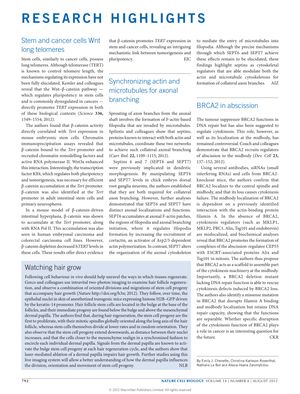Synchronizing Actin and Microtubules for Axonal Branching
August 2012
in “
Nature Cell Biology
”

TLDR Certain proteins help nerve cells branch, and other findings relate to cancer, stem cell behavior, and cell division.
The document discusses several research findings related to cellular mechanisms. One study revealed that the Wnt-ß-catenin pathway, which is involved in stem cell pluripotency and cancer, promotes the expression of telomerase (TERT) in both stem and cancer cells, suggesting a link between tumorigenesis and pluripotency. Another study showed that proteins called septins coordinate actin and microtubule networks to facilitate collateral axonal branching in neurons. Additionally, a study using intravital two-photon imaging observed the behavior of hair follicle stem cell progeny during hair regeneration, finding that these cells proliferate and orient themselves along the hair follicle axis, influenced by signals from the dermal papilla. Lastly, research on the tumor suppressor BRCA2 demonstrated its role in cytokinesis, where it recruits regulators of abscission to the midbody, independent of its DNA repair function. These findings provide insights into the regulation of telomere length, neuronal branching, hair growth, and cell division, with implications for understanding cancer and regenerative processes.


